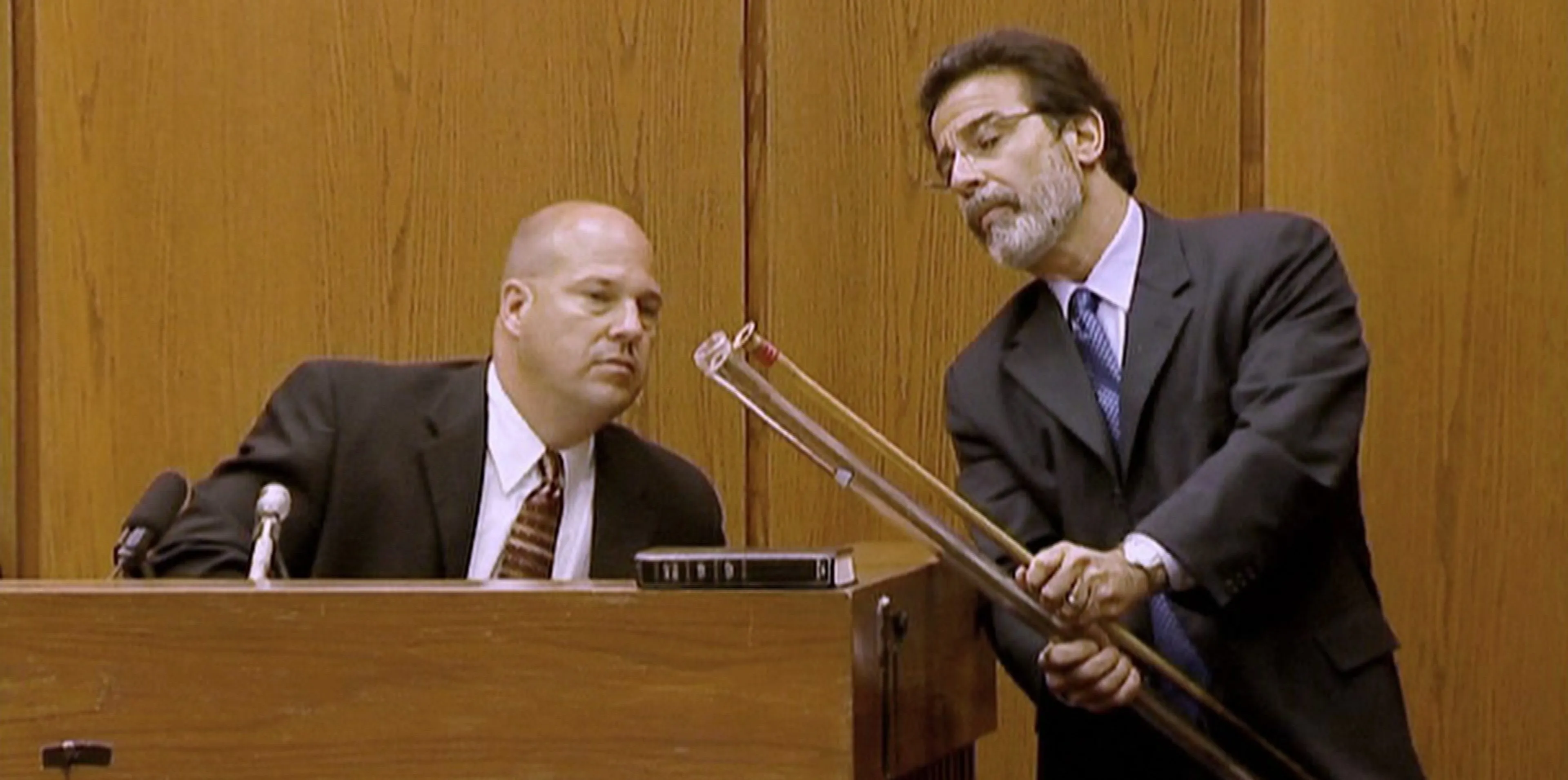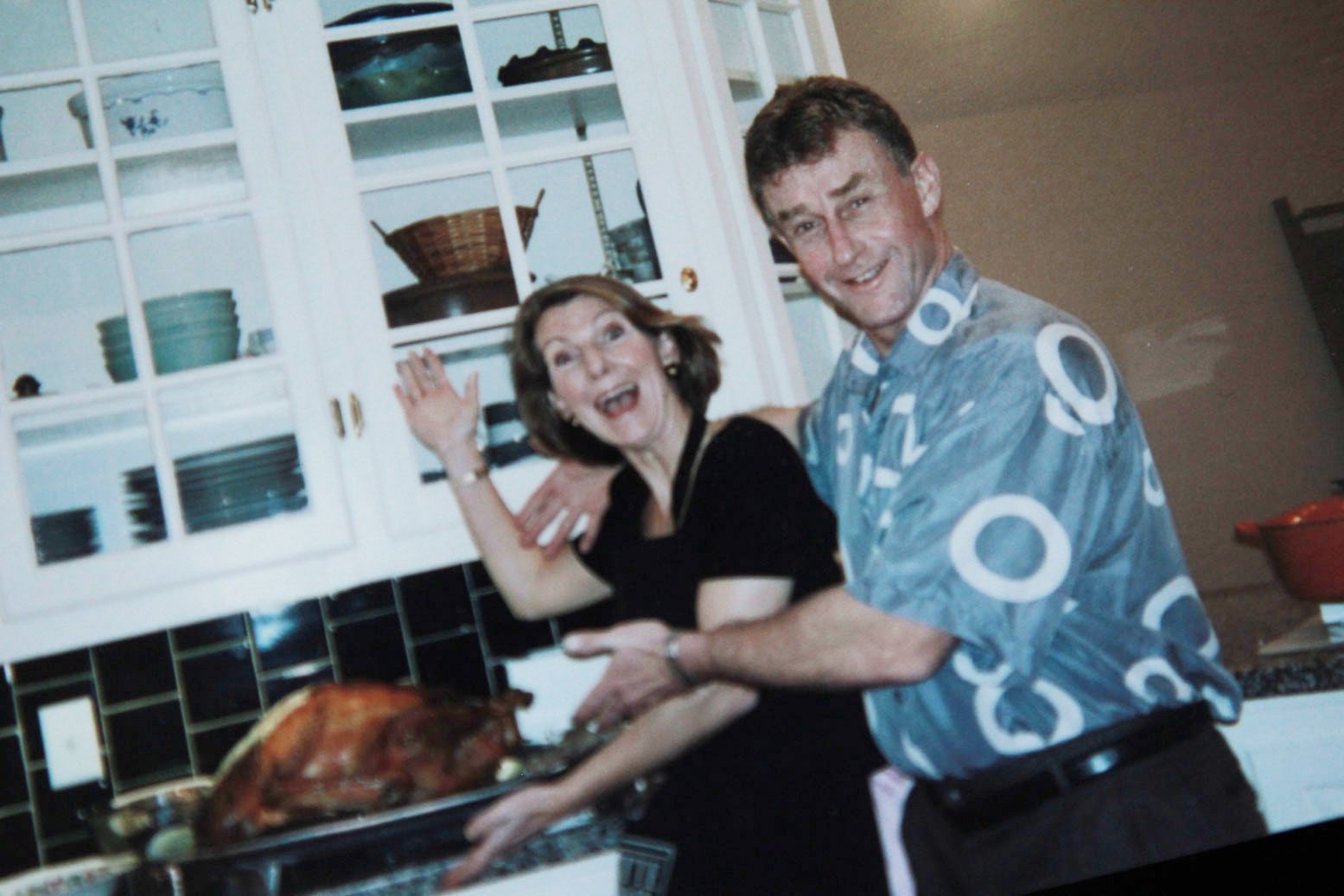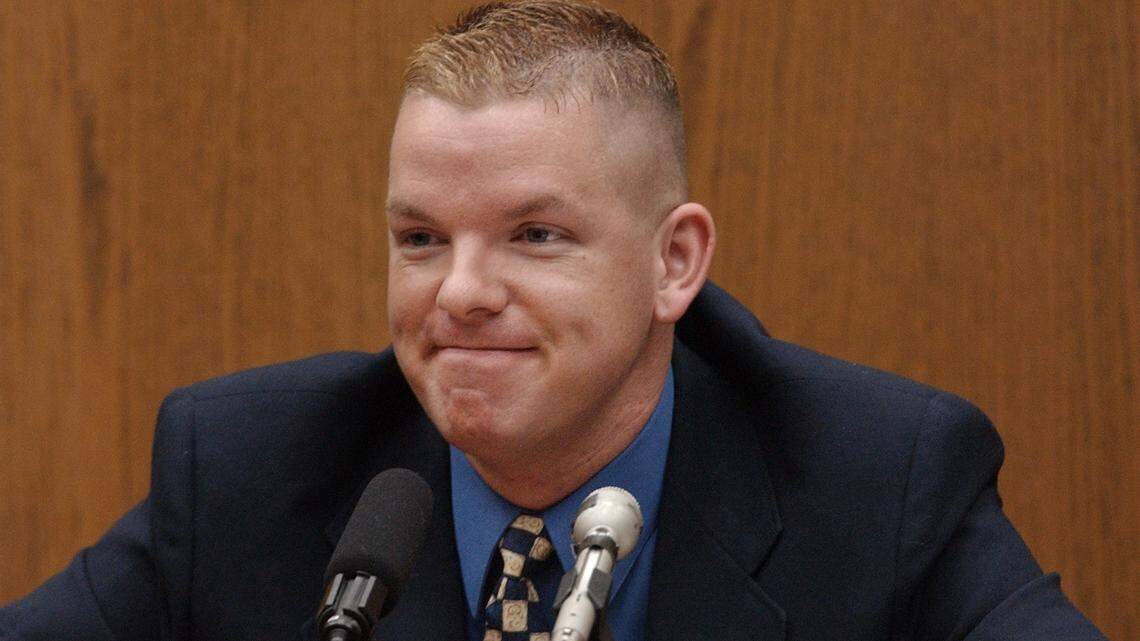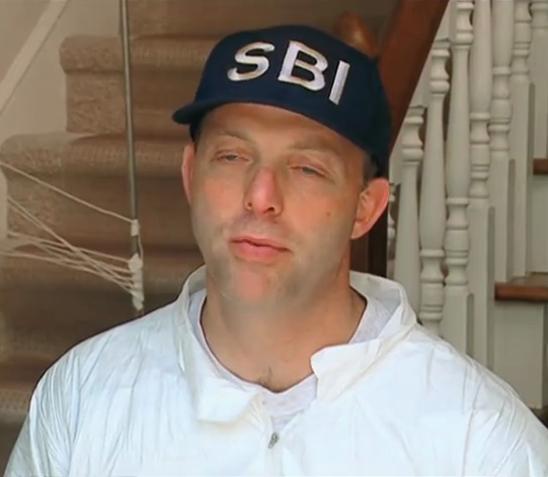Michael Peterson and the Staircase Murders

December 9th, 2001. A 911 call at 2:40 in the morning. Michael Peterson says his wife fell down the stairs. But it's not what he said. It's how he said it. And when prosecutors started digging into his past, they found another body. Another staircase. Another wife of a friend. Dead the exact same way. Part 1 of a story where nothing is what it seems.
You can listen to this episode here.
The 911 Call That Started Everything
At 2:40 in the morning on December 9th, 2001, Michael Peterson called 911 from his home in Durham, North Carolina. His wife Kathleen was at the bottom of the staircase. She wasn't moving. There was blood everywhere. And the first words out of his mouth were, "My wife had an accident. She fell down the stairs."
That sentence would become one of the most analyzed pieces of evidence in the entire case. Not because of how he sounded. But because of what he said and when he said it.
Here's the thing. If you just walked into your house and found your spouse covered in blood at the bottom of a staircase, what would you say? Most people would be frantic. They'd describe what they're seeing. They'd say something like, "There's so much blood, please hurry, I don't know what happened." They wouldn't immediately offer an explanation for how it happened.
But Michael Peterson did. Before he even described the scene to the operator, he told her it was an accident. He told her Kathleen fell down fifteen to twenty stairs. He was providing a narrative before anyone asked for one.
Experts who analyze 911 calls for signs of deception flagged this immediately. When someone is genuinely discovering a traumatic scene for the first time, they don't have the answers yet. They're reacting to what they see. They're asking for help. They're not explaining cause and effect.
Peterson also said Kathleen was "still breathing." That word, "still," suggests he's monitoring her condition. Like he's been watching and waiting for something to change. It's a small word, but it implies a timeline that doesn't match the story of a husband who recently walked in and found his wife injured.
The prosecution would later argue that Peterson's 911 call sounded scripted. That he wasn't discovering his wife's body. He was narrating a scene he already knew about.
What the Crime Scene Revealed
When investigators arrived, they found Kathleen Peterson dead at the bottom of the main staircase. The scene was disturbing. There was an enormous amount of blood. It was on the walls, on the stairs, pooled on the floor. The medical examiner counted seven deep lacerations on Kathleen's scalp. The cause of death was determined to be blunt force trauma from blood loss caused by those injuries. On December 20th, 2001, her death was ruled a homicide. Michael Peterson was indicted for first-degree murder.
But here's where the case gets complicated. Despite those seven deep cuts to her head, Kathleen had no skull fracture. No broken bones. No brain injury. No subdural hematoma. Nothing.
Defense experts would later point out that in hundreds of documented cases where someone was beaten to death, there was always massive brain injury, skull fractures, or other broken bones. Always. A fatal beating doesn't just cause scalp lacerations. It destroys the structures underneath.
So the defense had a theory. Kathleen fell down the wooden stairs. Her head hit the sharp edges of the steps multiple times. That's what caused the lacerations. And the reason there was so much blood was because scalp wounds bleed heavily. Add in the possibility that she coughed up blood or that it mixed with urine, and you've got a crime scene that looks worse than the actual injury.
The prosecution had a different theory. Someone beat Kathleen Peterson to death. And that someone was her husband.
Who Was Michael Peterson?
Michael Peterson was a novelist and a former Marine. He had written books based on his military experience, including The Immortal Dragon and A Time of War. He had run for mayor of Durham. He had worked as a newspaper columnist, and in that role, he had been openly critical of local law enforcement and the district attorney, James Hardin Jr. The same district attorney who would later prosecute him.
Michael and Kathleen had what looked like a happy blended family. Kathleen was a successful executive at Nortel. They had kids from previous marriages. They also had guardianship of Margaret and Martha Ratliff, the daughters of Michael's deceased friend, Elizabeth Ratliff.
That last detail is important. Because Elizabeth Ratliff's death would become the centerpiece of the prosecution's case.
The Second Staircase
In 1985, Michael and his first wife Patti were living in Germany. Their friend and neighbor, Elizabeth Ratliff, was found dead at the bottom of her staircase. She had recently lost her husband. Michael had been the last person to see her alive. He had dinner with her that night and helped put her two young daughters to bed.
When Elizabeth was found the next morning by her nanny, German police and U.S. military authorities investigated. They concluded she had died of natural causes. Specifically, a brain hemorrhage, possibly related to a blood disorder called Von Willebrand's disease. The official finding was that she collapsed from the hemorrhage and then fell down the stairs.
After her death, Michael and Patti took in Elizabeth's two daughters and raised them as their own.
That should have been the end of it. But seventeen years later, prosecutors in North Carolina saw an opportunity.
Digging Up the Past
The prosecution petitioned the court to exhume Elizabeth Ratliff's body from Texas and bring it to Durham for a second autopsy. This happened just three weeks before Michael Peterson's trial was set to begin. The defense fought hard against this, arguing that they were being forced to defend against two separate deaths at the same time, which would severely prejudice their case.
But the judge allowed it.
The Durham medical examiner, the same one who had performed Kathleen's autopsy, conducted the re-evaluation. And suddenly, the findings changed. The second autopsy concluded that Elizabeth Ratliff's death was a homicidal assault. Seven cuts from multiple blunt force impacts. The new ruling said her injuries were inconsistent with a simple fall.
The prosecution never formally accused Peterson of murdering Elizabeth Ratliff. But they didn't have to. They just needed to get her death into the trial.
Rule 404(b) and the Pattern That Wasn't
The legal mechanism they used is called Rule 404(b). It governs when you can introduce evidence of other crimes or bad acts in a trial. The rule says you can't use prior bad acts to show that someone has a pattern of behavior and therefore probably did the thing they're accused of. That's explicitly prohibited.
But there's an exception. You can introduce prior bad acts if they prove something specific. Like motive. Or intent. Or identity. Or the absence of accident.
The judge ruled that the Elizabeth Ratliff evidence was admissible to show the absence of accident. The prosecution argued that two women dying at the bottom of staircases, both connected to Michael Peterson, couldn't possibly be a coincidence. Therefore, Kathleen's death wasn't an accident.
This ruling was devastating for the defense. Because now the jury wasn't just deciding whether Kathleen's death was a murder or an accident. They were being asked to believe that Michael Peterson had killed two women in nearly identical ways, seventeen years apart.
The emotional weight of that argument is massive. Even if the physical evidence in Kathleen's case was ambiguous, even if there were doubts about whether it was actually a murder, the presence of Elizabeth Ratliff's death created a narrative that was almost impossible to defend against. Two staircases. Two dead women. Same man. It didn't matter that the original German investigators found no evidence of foul play. It didn't matter that Michael had no motive to kill Elizabeth. The pattern itself became the evidence.
The Secret Life
The prosecution also argued that Michael Peterson had a motive to kill Kathleen. And that motive was rooted in his sexuality.
Investigators discovered that Michael Peterson was bisexual. Between August and September 2001, he had exchanged emails with a male escort and made plans to meet, although the meeting never happened. The prosecution immediately sought to introduce this evidence, arguing it was crucial to proving motive.
The judge allowed it, ruling that it "goes to motive." The prosecution's theory was that Michael's sexuality and his attempts to pay for sex proved the marriage was unstable. They argued that if Kathleen had discovered this secret, it could have led to a violent confrontation. They also pointed to financial difficulties and a $1.5 million life insurance policy.
The defense pushed back hard. Peterson's attorney argued that Kathleen knew about and accepted Michael's bisexuality. That they were soulmates. That their relationship wasn't compromised by his sexual orientation. Even the male escort testified that Peterson had spoken warmly about his wife, describing a relationship that nothing could destroy. The escort also noted that many of his clients were married men whose wives knew about their sexuality.
But the damage was done. The prosecution spent significant time in closing arguments asking the jury if they really believed Kathleen knew her husband was bisexual. The implication was clear. A bisexual man who contacted an escort couldn't have a happy marriage. And if he couldn't have a happy marriage, he had a motive to kill.
This was biphobia dressed up as legal argument. And it worked.
Escort that exchanged emails with Michael Peterson
The Blood Spatter Expert Who Knew Too Much
The prosecution's case relied almost entirely on one witness. Duane Deaver, an agent with the State Bureau of Investigation. Deaver was a blood spatter analyst, and his testimony was the only evidence that directly tied Michael Peterson to the act of killing Kathleen.
Deaver testified that the blood patterns in the stairwell showed several points of origin above the floor. He said this couldn't be explained by an accidental fall. More importantly, he testified that the blood on Michael Peterson's clothing showed spatter penetration that was inconsistent with Peterson's story. Peterson had said he cradled Kathleen's body after finding her. Deaver said the blood patterns proved Peterson was present when the blows were inflicted.
But here's something interesting. Deaver had declared Kathleen's death a homicide within ninety minutes of arriving at the Peterson home. Before he did any formal analysis. Before he conducted any experiments. He walked in, looked around, and decided it was murder.
The defense brought in their own experts, including Dr. Henry Lee. They argued that the injuries were consistent with an accidental fall. That the large amount of blood came from profuse bleeding from deep scalp wounds, possibly mixed with coughed-up blood or urine. They emphasized that a fatal beating that leaves no skull fracture and no brain injury is medically unusual.
There was even a theory that got some attention later, though it sounds absurd at first. The Owl Theory. This theory suggested that Kathleen was attacked outside by a barred owl, a species known to attack humans. The owl's talons could have caused the scalp lacerations. Kathleen could have rushed inside, disoriented from blood loss, and collapsed down the stairs. There were some details that supported this. Two of the scalp wounds were shaped like owl talons. There were tiny wounds consistent with a beak. There were drops of blood outside the front door. And there was a feather found on Kathleen's body.
The theory sounds wild. But it highlights something important. The scalp injuries were unusual. If they could have been caused by something other than Michael Peterson beating his wife, then the entire prosecution theory falls apart.
Duane Deaver - SBI Blood Spatter Analyst
The Verdict
In October 2003, the jury found Michael Peterson guilty of murder. He was sentenced to life in prison without the possibility of parole.
The conviction rested on Duane Deaver's blood spatter testimony. On the prejudicial introduction of Elizabeth Ratliff's death. On the insinuation that a bisexual man with a secret couldn't be trusted. And on the absence of any other explanation that the jury found believable.
But the physical evidence was ambiguous. No murder weapon was ever found. The blow poke that prosecutors theorized he used was later discovered by the defense in the garage, and the jury dismissed it. There was no eyewitness. No confession. No direct evidence linking Michael Peterson to a violent act.
What the prosecution had was a story. And sometimes, a compelling story is enough.
Michael Peterson would spend the next eight years in prison. But the story wasn't over. Because the foundation of his conviction was about to crumble.
PART 2
Michael Peterson was convicted of murder in 2003 based on blood spatter testimony from a state expert. Eight years later, investigators discovered that expert had been lying in cases for years. Fabricating evidence. Hiding exculpatory findings. Committing perjury. This is Part 2, where everything falls apart and a man has to choose between freedom and vindication.
The Foundation Cracks
After Michael Peterson was convicted in October 2003 and sentenced to life in prison, he filed appeals. Those appeals were initially rejected as they moved through the North Carolina court system. For years, it looked like the case was over. Peterson was in prison. Kathleen's family had their conviction. The legal system had spoken.
But then something happened that nobody expected. An independent review of the State Bureau of Investigation revealed a massive problem. And that problem had a name: Duane Deaver.
Remember, Deaver was the blood spatter analyst whose testimony was the only direct evidence linking Michael Peterson to Kathleen's death. He was the one who said the blood patterns proved Peterson was present when the blows were struck. He was the one who declared it a homicide within 90 minutes of arriving at the scene. The district attorney himself had called Deaver indispensable to the case.
The independent review found that Deaver had a long-standing pattern of fabricating evidence to support the prosecution. He concealed exculpatory evidence that could have helped defendants. And he committed perjury. This wasn't a one-time mistake. This was systematic misconduct spanning multiple cases over years.
In 2011, Deaver was fired from the SBI.
What This Meant for Peterson
The legal implications were severe. Deaver's testimony was the core of the prosecution's case. Without it, there was no evidence placing Michael Peterson at the scene as the person who killed Kathleen. Everything else was circumstantial. The 911 call. The bisexuality. The Elizabeth Ratliff case. None of that proved Michael Peterson beat his wife to death.
When you build a murder conviction on the testimony of one forensic expert, and that expert turns out to be a fraud, you have a due process violation. The defendant didn't get a fair trial. The jury made their decision based on lies.
Peterson's defense team filed a motion for a new trial based on this discovery. And in December 2011, Superior Court Judge Orlando Hudson, the same judge who had presided over the original trial, granted the motion. Judge Hudson stated that Deaver had "misled him and the jury" and confirmed that Peterson was entitled to a new trial.
On December 16, 2011, after serving eight years in prison, Michael Peterson was released.
The Dilemma
You would think this would be cause for celebration. The conviction was overturned. The key witness was exposed as a liar. Peterson was free. But freedom doesn't mean vindication. And it doesn't mean the nightmare is over.
The state still planned to retry Peterson. A new trial was scheduled for 2017. And this created an impossible situation for the defense.
On one hand, they had won. They had proven that the original conviction was based on fraudulent testimony. Deaver, the star witness, was discredited. Without him, the prosecution's case was significantly weaker.
But on the other hand, Peterson would still have to face a jury. And that jury would still hear about Elizabeth Ratliff. They would still hear about his bisexuality and the emails with a male escort. They would still see the crime scene photos. They would still hear the 911 call analyzed by experts who thought it sounded rehearsed. All of that highly prejudicial, emotionally charged evidence would still be admissible.
Peterson himself said it plainly: "Am I going to put my life and my freedom in the hands of the Durham police and the District Attorney? Look what they did the first time."
He didn't trust the system. And honestly, why would he? The system had already put him in prison based on lies.
The Risk Assessment
The defense team had to weigh the risks. If Peterson went to trial and lost, he would go back to prison for life. He had already spent eight years there. He was older now. Another life sentence would mean he would die in prison.
If he went to trial and won, he would be fully exonerated. His name would be cleared. He could say definitively that he didn't kill Kathleen. But winning wasn't guaranteed. Juries are unpredictable. And the cumulative weight of all that circumstantial evidence, even without Deaver, might be enough to convict him again.
There was a third option. A legal compromise that would allow Peterson to maintain his innocence while avoiding the risk of another trial. It's called an Alford plea.
What Is an Alford Plea?
An Alford plea is a guilty plea with a twist. The defendant pleads guilty to the charge, but they maintain their innocence. What they're acknowledging is that the prosecution has enough evidence that, if presented to a jury, would likely result in a conviction. But they're not admitting they actually did it.
It's a pragmatic legal tool. It's used when the risk of going to trial is too high, but the defendant refuses to lie and say they committed the crime. The court accepts the plea as a guilty plea for sentencing purposes, but the defendant gets to say on the record that they didn't do it.
On February 24, 2017, Michael Peterson entered an Alford plea to the reduced charge of voluntary manslaughter.
The Courtroom Statement
Peterson addressed the court after entering his plea. He said accepting the plea had been "the most difficult thing I've ever done." He used the opportunity to reinforce that he was "not responsible for her death in any way."
But legally, he was now a convicted felon. The charge was voluntary manslaughter instead of first-degree murder, but it was still a conviction. And because he had already served nearly 100 months in prison following his 2003 conviction, and the maximum sentence for voluntary manslaughter was 86 months, the time served covered his sentence. He walked out of the courtroom a free man.
The Reaction
Not everyone accepted this resolution. One of Kathleen's sisters spoke in court and rejected the Alford plea as meaningless. She said, "An innocent man does not plead guilty. Mr. Peterson plead guilty today." From her perspective, the legal distinction didn't matter. He entered a guilty plea. Therefore, he was guilty.
And I understand that reaction. If someone in my family was killed, and the person accused of killing them took an Alford plea, I would feel cheated. Because there's no closure. There's no trial. There's no jury verdict. There's no definitive answer.
But from Peterson's perspective, what choice did he have? Risk everything on a jury that might convict him again based on the same prejudicial evidence? Spend the rest of his life in prison for something he says he didn't do? Or take the plea, walk free, and maintain his innocence on the record?
He chose freedom.
What Actually Happened?
So here's where we are. Legally, Michael Peterson is a convicted felon who pleaded guilty to voluntary manslaughter. But he maintains he's innocent. The conviction that sent him to prison was based on fraudulent forensic testimony. The prosecution's theory relied heavily on biphobia and the prejudicial introduction of another woman's death that German authorities had ruled accidental.
The physical evidence was always ambiguous. Seven deep cuts to the scalp, but no skull fracture and no brain injury. Blood everywhere, but no murder weapon. A 911 call that sounded prepared, but also a man who might have been in shock. An alleged motive based on his sexuality, but also testimony that Kathleen knew about and accepted his bisexuality.
We will never know for certain what happened at the bottom of that staircase on December 9th, 2001. Did Kathleen fall? Was she beaten? Was she attacked by an owl and then fell? Did Michael Peterson kill his wife? Or did he find her dying and panic?
The courts didn't answer that question. They couldn't. Because the evidence was never strong enough to prove murder beyond a reasonable doubt without Duane Deaver's lies.
The Bigger Picture
The Michael Peterson case is a perfect example of how the justice system can fail in multiple ways at once. It failed Kathleen Peterson by not definitively determining how she died. It failed Michael Peterson by convicting him based on fraudulent testimony. It failed both families by creating a legal resolution that provides no real closure.
But it also exposes something darker. The willingness of the justice system to use prejudice as a substitute for evidence. The prosecution didn't prove Michael Peterson killed his wife. What they proved was that he was bisexual, that he had contacted a male escort, and that another woman he knew had died under somewhat similar circumstances seventeen years earlier.
They took those facts and built a narrative. A narrative that relied on the jury believing that a bisexual man couldn't have a happy marriage. That a man connected to two staircase deaths must be a killer. That blood spatter patterns interpreted by a corrupt analyst were more reliable than the absence of skull fractures and brain injuries.
And it worked. Until it didn't.
The Peterson case also demonstrates how dependent the criminal justice system is on expert testimony. Juries don't understand blood spatter analysis. They don't know how to interpret scalp lacerations. They rely on experts to tell them what the evidence means. And when those experts lie, the entire system breaks down.
Duane Deaver wasn't the only forensic analyst found to have committed misconduct. Forensic science, particularly in areas like bite mark analysis, hair comparison, and even blood spatter, has come under intense scrutiny in recent years. Many of these techniques aren't as scientifically reliable as juries believe. And when analysts fabricate results or overstate their conclusions, innocent people go to prison.
Where Things Stand Now
Michael Peterson is a free man. He lives with the voluntary manslaughter conviction on his record. He has maintained his innocence in interviews and documentaries. The case has been covered extensively, including in the documentary series The Staircase, which followed the trial and appeals over many years.
Kathleen Peterson's family still believes Michael killed her. They believe the Alford plea was an admission of guilt, regardless of the legal technicalities.
The case remains unresolved in the way that matters most. We don't have a definitive answer. We have a legal compromise that satisfied no one.
And maybe that's the most honest conclusion. Sometimes the evidence doesn't lead to certainty. Sometimes the justice system can't deliver the truth. Sometimes all we're left with is doubt.
Michael Peterson says he didn't kill his wife. The state of North Carolina says he pleaded guilty to killing her. And Kathleen Peterson is still dead at the bottom of a staircase, with seven cuts on her head and no clear explanation for how they got there.
That's where this story ends. Not with answers. But with the uncomfortable reality that some questions don't have them.











